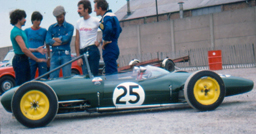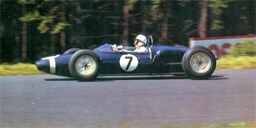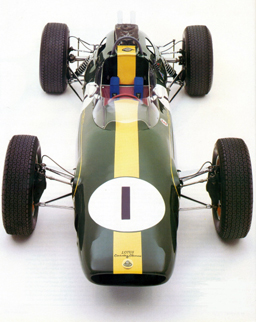Formula Ford's Ancestors
Formula 500 / Formula 3
One of the main precursors to Formula Ford was the 500 / F3 Class. When racing resumed in England after the war, inexpensive and plentiful 500 CC motorcycle engines were put in small, nimble chassis - most notably those built by Charles and John Cooper - and huge grids appeared out of nowhere!
| This example is a Cooper, Stirling Moss's first pure racing car. In such cars, with varying engine sizes, Moss ran over 80 races and hill climbs. |  |
Formula Junior
From 1958 to 1963, Formula Junior replaced the motorcycle engined 500 cc F3 cars as the stepping-stone to Formula 1. Count Giovanni 'Johnny' Lurani-Cernuschi was the primary advocate of the new class which used 1000 cc engines based on production cars then available. In 1958 the CSI granted it international status for 1959.
Initially the Italian cars, and in particular the Stanguellini-Fiats dominated by winning the Italian championships in 1958 and 1959 and the International championship in its first year with a car driven by Michael May of Switzerland. But by the end of 1959 there were other manufacturers building cars including Elva, Cooper, Lotus and Lola.
 |
A wide assortment of cars were produced and the engines - mostly Fiats and BMC variants - came from a wide variety of street cars. This one is a beautifully restored Lotus, seen here in the paddock at Donnington Park at a huge vintage meet of the type the English do so well! |
From 1960 on, British built cars totally dominated Formula Junior, particularly the works teams from Lotus with drivers such as Jimmy Clark, Trevor Taylor and Peter Arundel, all of whom progressed through to Formula One with Clark winning two world championships.
Who would have thought that Formula Junior with such a short international life span would make such an impact on the motor racing world and revolutionize Formula One so drastically? During the six years of its existence, racing car design evolved from front engine with ladder style chassis, to the more sophisticated monocoque with rear engine of current design.
| This example of a Lotus familiar to Formula Junior grids shows off its distinctive green livery with characteristic flashy, yellow "wobbly" wheels. |  |
After 1960, Formula 2 and 3 were dropped in favor of Formula Junior, making it the only doorway to Formula One for aspiring drivers. But Formula Junior was soon replaced by the reintroduction Formula 2 and 3 in 1964. Slightly later in the sixties, the idea of a low-cost introduction to single-seater racing would return in the form of Formula Ford.
Formula One
Early FF cars being built in 1967 and the years that followed were based on Formula Junior cars of a few years earlier. They also followed a theme which originated in workshops of John Cooper, Enzo Ferrari, and Colin Chapman!
 |
LOTUS-CLIMAX 18/21 Stirling Moss at the Nurburgring - 1961 |
 |
LOTUS 25 In May 1963, racing car design took a major leap forward when Jim Clark took Colin Chapman's Lotus 25 out onto the Zandvoort Circuit. It's stunning innovation was its monocoque chassis - an aluminum tub that weighed only 70 pounds! Its little 1.5 liter Coventry-Climax engine was not fully stressed. That development would have to wait until Ford and Cosworth created the great 3 liter DFV - an engine whose heads were based on the Cosworth heads that were in Formula Two cars at that time. The blocks were 1.6 liter crossflow Fords - the early version of the Kent! |
 |
FERRARI 312 Even the Ferrari Formula One cars of the late 60's provided inspiration for designers of the humble Formula Fords! Here, Chis Amon powers up the long back straight at Watkins Glen in 1968. |
 |
COOPER T51 This car was built up for the Tasman Series and was based on current Cooper World Championship F1 cars in which Jack Brabham took the crown in 1959 and 1960. A low-slung version really set the design standard for all F1 cars for several years. |
Indianapolis Cars
Following Jack Brabham's successful run at Indy in 1961 with a Grand Prix Cooper, the movement toward rear engined cars and away from the classic Indy "roadster" began in earnest.
|
This Mickey Thompson built Harvey Aluminum car, for example, was driven by Dan Gurney at Indianapolis in 1962. Sporting a much modified stock block Buick V8, it ran very well in the 500 until a simple oil seal let go and Gurney's day was over, but not before he had moved up through the field impressively. |
 |
|
Thompson's later Indy cars utilized revolutionary small diameter tires which made them very difficult to control. They were deemed to be too dangerous by several top line drivers who tried them. Road racer Dave McDonald would lose his life in one during the '64 race. |
 |
By the early 70's, the FF contingent found that they could be driving cars that looked almost exactly like the current crop of F1 and Indy cars. Since wings were not yet in vogue, all the rear engined open wheel cars at that time appeared to be part of a single family.
Take a look at The Cars of Formula Ford.